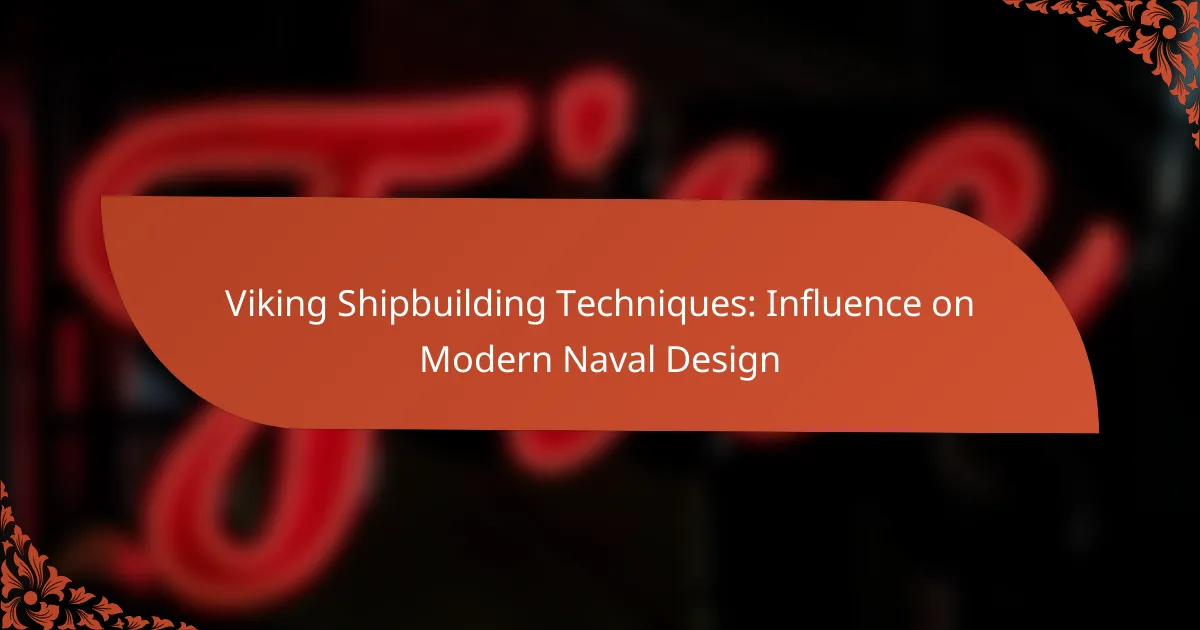Viking shipbuilding techniques have left a lasting legacy on modern naval design, showcasing innovative hull shapes and construction methods that prioritize performance and stability. The ancient practices of clinker-building and the use of natural materials continue to inspire contemporary shipbuilding, emphasizing efficiency and adaptability in maritime engineering.

How did Viking shipbuilding techniques influence modern naval design?
Viking shipbuilding techniques have significantly influenced modern naval design by introducing innovative hull shapes, construction methods, and sail technologies that enhance performance and stability. These ancient practices continue to inform contemporary shipbuilding, emphasizing efficiency and adaptability in maritime engineering.
Innovative hull designs
The Vikings pioneered long, narrow hull designs that allowed for greater speed and maneuverability in various water conditions. This design principle is evident in modern naval vessels, where sleek hull shapes reduce drag and improve fuel efficiency. Contemporary shipbuilders often draw inspiration from these ancient forms to create vessels that can navigate both open seas and shallow waters effectively.
For instance, the use of a sharp bow and a shallow draft in Viking ships has been adapted in modern designs for patrol boats and recreational craft, allowing them to operate in diverse environments.
Use of clinker construction
Clinker construction, characterized by overlapping wooden planks, provided Viking ships with flexibility and strength, enabling them to withstand rough seas. This technique has influenced modern shipbuilding by highlighting the benefits of using composite materials that offer similar resilience while reducing weight. Many modern yachts and small boats utilize variations of this method to enhance durability without compromising performance.
Additionally, the ease of repair associated with clinker-built vessels allows for quick fixes in the field, a principle that is valuable in today’s naval operations where downtime can be costly.
Impact on ship stability
The design features of Viking ships, including a low center of gravity and wide beam, contributed to their exceptional stability in turbulent waters. Modern naval architects incorporate these stability principles into the design of various vessels, ensuring they can handle adverse conditions effectively. This focus on stability is crucial for military ships and cargo vessels that operate in unpredictable environments.
By understanding the balance and weight distribution used in Viking ships, contemporary designers can create vessels that are not only stable but also capable of carrying heavier loads without compromising safety.
Adaptation of sail technology
The Vikings were among the first to use square sails, which allowed for better wind capture and improved sailing efficiency. This innovation has been adapted in modern naval design, where sail technology continues to evolve with materials like synthetic fibers that enhance durability and performance. The principles of sail design from Viking ships inform the development of both recreational sailing vessels and advanced naval ships.
Modern sailing vessels often incorporate features inspired by Viking technology, such as adjustable sails that optimize performance across various wind conditions, demonstrating the lasting impact of these ancient techniques on contemporary maritime practices.

What are the key Viking shipbuilding techniques?
Viking shipbuilding techniques were characterized by innovative methods that emphasized speed, durability, and adaptability. Key techniques include the clinker-built method, keel construction, and the use of natural materials, all of which have influenced modern naval design.
Clinker-built method
The clinker-built method involves overlapping wooden planks, which creates a flexible and strong hull. This technique allows for easier repairs and modifications, making vessels more resilient to the harsh conditions of the sea.
Modern shipbuilders often draw inspiration from this method, as it enhances the structural integrity of boats while reducing weight. The flexibility offered by clinker construction is particularly beneficial for vessels that need to navigate both open waters and shallow rivers.
Keel construction
The keel is the backbone of a ship, providing structural support and stability. Viking ships featured a robust keel that was integral to their design, allowing for better handling and performance in various sea conditions.
In contemporary naval design, the principles of keel construction remain crucial. A well-designed keel can significantly improve a ship’s maneuverability and seaworthiness, making it a fundamental consideration in modern shipbuilding.
Use of natural materials
Vikings primarily used locally sourced timber, such as oak and pine, which provided strength and flexibility. This reliance on natural materials not only made construction more sustainable but also ensured that ships were well-suited to their environments.
Today, the use of natural materials is gaining traction in eco-friendly shipbuilding practices. Modern designers are exploring sustainable woods and composites that mimic the properties of traditional materials, aiming to reduce environmental impact while maintaining performance.

How do Viking ships compare to modern naval vessels?
Viking ships were designed for speed, agility, and versatility, which contrasts with the larger, more specialized modern naval vessels. While Viking ships excelled in shallow waters and quick maneuvers, contemporary ships prioritize cargo capacity, advanced technology, and durability for various missions.
Size and capacity differences
Viking ships typically ranged from 20 to 30 meters in length and could carry around 20 to 60 tons, accommodating crews of up to 100 warriors. In contrast, modern naval vessels can exceed 100 meters in length and carry thousands of tons, supporting larger crews and extensive equipment.
The size difference reflects the evolution of naval design, with modern ships built for specific roles such as aircraft carriers, destroyers, and submarines, each optimized for their intended mission.
Material advancements
Viking ships were primarily constructed from oak, which provided strength and flexibility. The use of wood limited their durability, requiring regular maintenance and repairs. Modern naval vessels, however, utilize advanced materials such as steel, aluminum, and composite materials, enhancing durability and reducing maintenance needs.
These material advancements allow modern ships to withstand harsher conditions and extend operational lifespans, making them more effective in various maritime environments.
Design efficiency
The design of Viking ships emphasized a shallow draft, allowing them to navigate rivers and coastal areas effectively. This efficiency was crucial for raiding and trading. Modern naval design focuses on hydrodynamics and stealth, incorporating technologies that reduce drag and improve fuel efficiency.
Modern ships often feature complex hull designs and propulsion systems that optimize speed and maneuverability, reflecting a shift towards multi-role capabilities and operational flexibility in naval warfare.

What are the benefits of studying Viking shipbuilding?
Studying Viking shipbuilding offers valuable insights into historical maritime practices and their lasting impact on modern naval architecture. It reveals techniques that not only advanced ship design in the past but also continue to influence contemporary vessel construction.
Insights into maritime history
Viking shipbuilding techniques provide a window into the maritime history of the Norse people, showcasing their innovative approaches to navigation and trade. By examining the materials and methods used, historians can better understand the cultural and economic factors that shaped Viking society.
For example, the use of clinker-built construction, where overlapping planks were fastened together, allowed for lighter and more flexible vessels. This technique enabled Vikings to traverse various waterways, from open seas to shallow rivers, enhancing their exploration and trade capabilities.
Influence on contemporary ship design
Modern naval design has been significantly influenced by Viking shipbuilding methods, particularly in terms of hull shape and construction techniques. The principles of hydrodynamics observed in Viking longships are still relevant today, as they emphasize speed and stability.
Contemporary shipbuilders often draw inspiration from the Viking approach to materials, favoring lightweight yet durable options that improve performance. The integration of traditional craftsmanship with modern technology continues to evolve, reflecting the enduring legacy of Viking innovations.
Understanding ancient engineering
Viking shipbuilding exemplifies advanced engineering principles that were ahead of their time. The ability to construct seaworthy vessels capable of long voyages demonstrates a sophisticated understanding of balance, weight distribution, and material properties.
By studying these ancient techniques, engineers can gain insights into sustainable practices and resource management. For instance, the use of locally sourced timber and natural adhesives in Viking ships highlights the importance of environmental considerations in engineering solutions.

What criteria should be considered when analyzing shipbuilding techniques?
When analyzing shipbuilding techniques, key criteria include material selection, design principles, construction methods, and historical context. Understanding these elements helps in evaluating how traditional practices influence modern naval design.
Material selection
Material selection is crucial in shipbuilding as it affects durability, weight, and performance. Traditional Viking ships were primarily constructed from oak, prized for its strength and resistance to rot, which is still relevant in modern shipbuilding.
When choosing materials today, consider factors such as availability, cost, and environmental impact. For instance, steel is commonly used for large vessels due to its strength, while lighter materials like fiberglass are favored for smaller crafts.
Common materials include:
- Wood (e.g., oak, pine) – traditional and sustainable
- Steel – strong and durable, often used in commercial ships
- Aluminum – lightweight and corrosion-resistant, suitable for high-performance vessels
- Composite materials – increasingly popular for their strength-to-weight ratio









